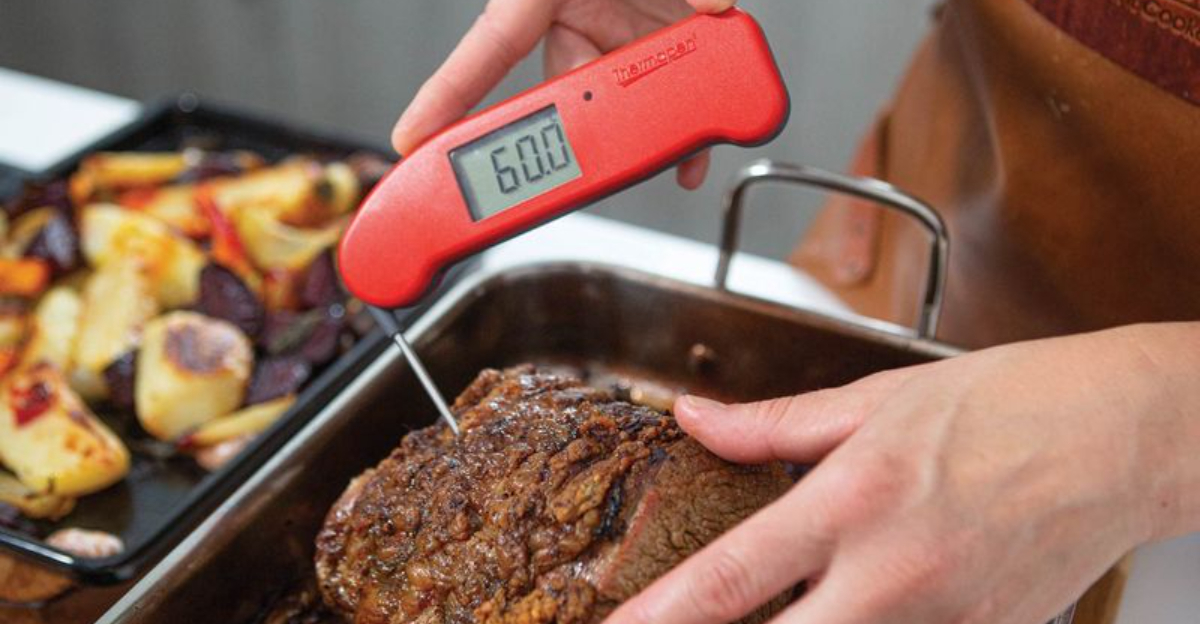20 Handy Hacks For Cooking Perfect Lamb Every Time

Cooking lamb can feel like walking a culinary tightrope. Too raw and it’s chewy, too done and it’s heartbreak on a plate. But when it’s just right? Pure magic.
Whether you’re roasting a leg for Sunday dinner or pan-searing chops on a whim, knowing a few tricks can make all the difference.
From mastering the marinade to nailing that perfect internal temp, these tips will help you treat lamb like the star it truly is.
1. Temperature Matters
Cold lamb hitting a hot pan is a recipe for tough, unevenly cooked meat. Taking your lamb out of the refrigerator 30-45 minutes before cooking allows it to warm up gently.
Room temperature meat cooks more evenly from edge to center, resulting in that perfect pink middle without charred exteriors. This simple step makes an enormous difference in texture and juiciness.
2. Fat Cap Scoring
Grabbing a sharp knife and making shallow diagonal cuts through the fat layer creates magic during cooking.
Those little channels allow rendered fat to baste the meat naturally while preventing the edges from curling up.
Plus, those scores become perfect pockets for herbs and spices to nestle into. Just don’t cut into the actual meat below the fat or you’ll lose precious juices.
3. Salt Generously
Forget those tiny salt shakers! Lamb needs bold seasoning, and coarse salt is your best friend here. Sprinkle it liberally over every surface at least 40 minutes before cooking.
The salt initially draws moisture out, then dissolves to form a brine that gets reabsorbed, seasoning the meat deeply.
This simple ingredient transforms lamb from bland to breathtaking without any fancy additions.
4. Thermometer Triumph
Guesswork leads to disappointment when cooking lamb. A good meat thermometer eliminates the mystery completely.
For medium-rare perfection, aim for 130-135°F in the thickest part. Remember that temperatures continue rising about 5 degrees during resting.
Digital instant-read versions give the most accurate readings and cost less than a good cut of lamb itself.
5. Searing Secrets
Cranking your stovetop or grill to screaming hot before the lamb touches it creates that gorgeous brown crust we all crave.
The Maillard reaction happening at high temperatures develops complex flavors impossible to achieve otherwise.
Wait until your pan is smoking slightly before adding the meat. Don’t move it for at least 2-3 minutes to allow that beautiful crust to form properly.
6. Tent for Tenderness
Rushing to slice into freshly cooked lamb is tempting but disastrous. Creating a loose foil tent over your finished lamb allows it to rest while keeping it warm.
During this crucial 10-minute period, juices redistribute throughout the meat instead of spilling onto your cutting board.
The temperature continues rising slightly while the muscle fibers relax, resulting in dramatically more tender meat.
7. Rack Roasting Revolution
Placing your lamb on a wire rack inside your roasting pan creates magic. Air circulates completely around the meat, preventing the dreaded soggy bottom syndrome that happens when meat sits in its own juices.
The result? Evenly browned, perfectly cooked lamb from all angles. As a bonus, those precious drippings collect cleanly below for an amazing sauce later.
8. Silver Skin Removal
That tough, silvery membrane clinging to some cuts of lamb is your enemy. Unlike fat, it never breaks down during cooking, instead turning chewy and unpleasant.
Slip a sharp knife beneath it and gently separate while pulling the membrane away.
Taking these extra minutes before cooking makes the difference between tough, stringy lamb and melt-in-your-mouth tenderness.
9. Reverse-Sear Success
Flipping traditional cooking methods upside down works wonders for thick lamb cuts.
Start by slow-roasting at 275°F until the internal temperature reaches about 10 degrees below your target.
Then finish with a blazing hot sear to develop that beautiful crust.
This technique gives you edge-to-edge consistent doneness with no overcooked outer ring, especially impressive when serving medium-rare lamb to discerning guests.
10. Basting Brilliance
Spooning hot fat and juices over your lamb during cooking is culinary magic at work. Each baste adds flavor while creating an even, golden exterior.
Tilt the pan slightly to pool the liquid, then use a large spoon to repeatedly drizzle it over the meat.
This simple motion, done every few minutes, keeps the surface moist and continually adds layers of flavor complexity.
11. Acid-Based Marinades
Yogurt, lemon juice, or vinegar in your marinade doesn’t just add flavor—they transform the meat’s texture.
These acidic ingredients break down tough protein strands, creating tenderness that no amount of careful cooking can achieve alone.
For best results, marinate lamb shoulder or leg cuts for at least 4 hours. The difference is remarkable, especially when using less expensive cuts that typically need longer cooking.
12. Dry Surface Magic
Moisture is the enemy of beautiful browning. Patting lamb completely dry with paper towels before seasoning creates the conditions for perfect searing.
Surface moisture causes steaming instead of browning, robbing you of flavor and texture.
This simple step takes seconds but dramatically improves your results, especially when using marinades or when the meat has been resting at room temperature.
13. Bone-In Benefits
Keeping the bone attached while cooking lamb isn’t just for presentation. Bones act as natural heat conductors, helping meat cook more evenly while protecting it from drying out.
They also contain marrow and connective tissues that melt during cooking, adding remarkable richness and depth to the meat closest to them.
That’s why the tastiest bites are often found right next to the bone.
14. Cross-Grain Cutting
Looking closely at cooked lamb reveals distinct muscle fibers running in one direction. Cutting perpendicular to these lines (against the grain) shortens these tough fibers, making each bite dramatically more tender. This technique matters most for cuts like leg of lamb or shoulder. When done correctly, even well-done lamb remains tender rather than chewy, solving the most common complaint about this delicious meat.
15. Preheating Perfection
Patience before cooking pays huge dividends with lamb. Allow your pan, grill, or oven to reach full temperature for at least 10-15 minutes before the meat goes in.
Properly preheated cooking surfaces immediately seal in juices and begin browning. This prevents the disappointing gray, steamed appearance that happens when lamb cooks slowly from a cold start.
16. Herb Harmony
Fresh garlic and rosemary create magic with lamb that dried versions simply cannot match. The aromatic oils in fresh herbs infuse the meat during cooking with bright, complex flavors.
Crush garlic cloves instead of mincing them to release their essential oils. Strip rosemary leaves from their woody stems before chopping.
These simple preparations maximize the impact of these classic lamb companions.
17. Deglaze Delights
Those browned bits stuck to your pan after cooking lamb are culinary gold! Adding liquid (wine, stock, or even water) while the pan is still hot dissolves these flavor bombs instantly.
Scrape gently with a wooden spoon to release everything. The resulting jus takes seconds to make yet adds restaurant-quality richness when drizzled over your sliced lamb.
18. Space Matters
Crowding lamb pieces in a pan creates steam instead of searing. Each piece needs at least an inch of space around it for proper browning and caramelization. Cook in batches if necessary rather than cramming everything in at once. The extra minutes spent are worth it for properly browned, evenly cooked lamb that hasn’t steamed in its own juices.
19. Broiler Brilliance
Finishing lamb under the broiler for the last 2-3 minutes creates an irresistible crispy exterior without overcooking the center.
Position the rack about 6 inches from the heat source for optimal results. Watch carefully during this final step as the high heat works quickly.
The reward is a beautiful golden crust with extra textural contrast that elevates the entire dish.
20. Patience Pays Off
The final 10 minutes of resting might be the most important part of cooking lamb. During this time, the temperature equalizes and juices redistribute throughout the meat.
Cutting too soon causes those flavorful juices to pool on your cutting board instead of remaining in the meat.
Set a timer if needed to resist the temptation to slice early, and you’ll be rewarded with dramatically juicier results.
